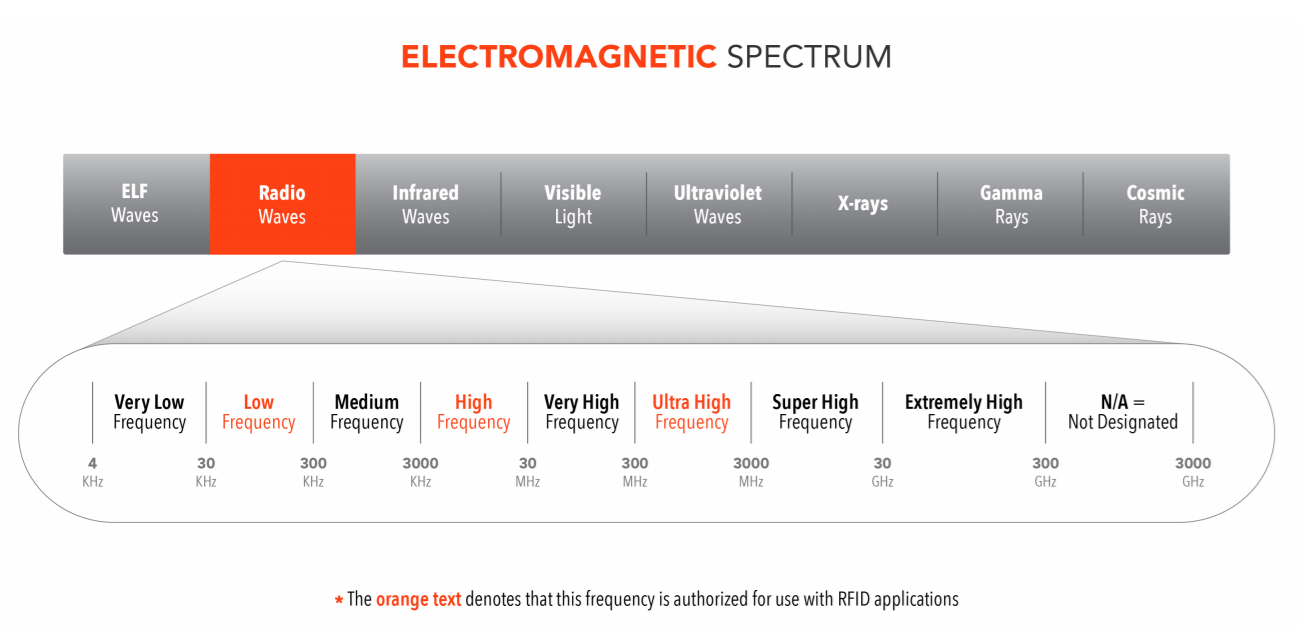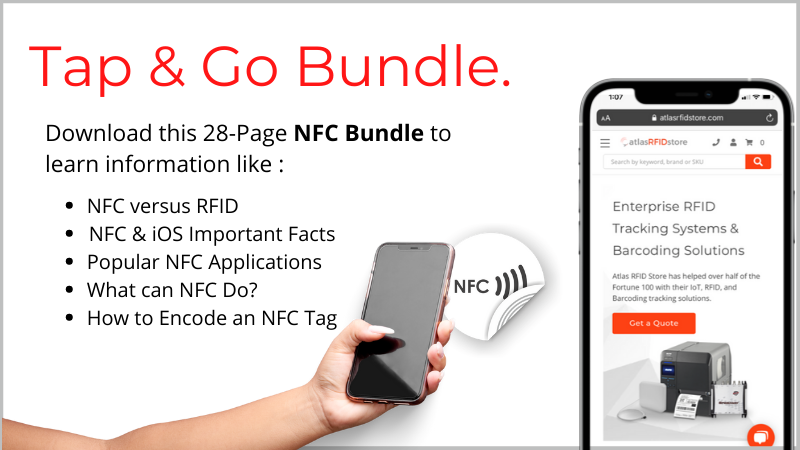29 NFC Q&As
Introduction
NFC, or Near-Field Communication, is a form of close proximity communication that uses RF energy to send and receive information. It is a form of RFID in the High Frequency (HF) range that communicates on a single frequency in that range, 13.56 MHz. Unlike other communication on the HF band, NFC is standardized via the International Organization of Standardization (ISO) to operate via ISO 14443 A and B and is regulated, which makes it easily adoptable globally.
Check out these frequently asked questions about NFC and their answers below. If you have a question that isn’t on this list, click on our Survey at the bottom so we can potentially add it to the list!
Section 1: NFC Basics
1. How does NFC work?
NFC works by transmitting and receiving data at short distances via magnetic coupling. When two NFC devices are in close proximity, they create an electromagnetic field in order to send and receive encoded data when in a specified range.
2. How far can NFC read?
NFC has a typical read range of only a few centimeters, around 4 cm or 1.5 in on average.
3. What is the difference between HF RFID and NFC?
NFC is a subset of the HF frequency range for RFID. HF RFID tags operate anywhere between 3 and 30 MHz on the Electromagnetic Spectrum, while NFC tags only operate on 13.56 MHz. NFC is also standardized and regulated through the ISO and the NFC Forum.

4. What are some examples of NFC chipsets & tags?
NXP Semiconductors is the most popular manufacturer of NFC chipsets. Some of their most popular chipsets include: NXP NTAG 213, NXP Ultralight EV1, and NXP ICODE SLIX.
Tag manufacturers use NXP’s or other chipsets to create NFC tags. Popular NFC tags include the SMARTRAC Circus, SMARTRAC Bullseye, Avery Dennison AD-740, Avery Dennison AD-721, and the Confidex Steelwave Micro II NFC tag.
5. How much do NFC tags typically cost?
In bulk quantities, disposable NFC labels can be as low as $0.13 per tag, but in lower quantities, they can be around $0.90 per tag. NFC hard tags in bulk average around $0.98 per tag but can be upwards of $2.00 when purchased individually.
6. Can anyone encode/read any NFC tag?
Most NFC-enabled devices can encode a blank tag and read any NFC tag; however, NFC tags can be locked or password protected, so they can’t be rewritten.
7. How can you read NFC tags?
NFC tags can be read via an NFC-compatible smartphone or an NFC RFID Reader. All you have to do is place the device close to the NFC tag, and it will automatically try to read it.
8. Do NFC tags have writeable memory?
Yes, NFC tag memory can be rewritten and averages between 48 bytes and 1 kB.
9. Can NFC tags work with any NFC reader or smartphone?
NFC tags can be read or encoded by any NFC reader or NFC compatible Smartphone (see updated list) which includes Android phones. In order to use the smarter functionalities of NFC tags like opening a URL, turning on Wi-Fi or Bluetooth, or adding contact information, the Reader or Smartphone must be set up according to the NFC Data Exchange Format, or NDEF.
*All iOS devices must use the NDEF standard to read or encode NFC tags.
10. Can NFC tags be customized?
Yes, NFC labels can be customized, but NFC hard tags cannot; however, NFC hard tags can be custom encoded and provided with custom, stick-on labels for identification. An NFC printer can print numbers, text, barcodes, or branding information on most compatible NFC labels. Checkout some examples below.

Section 2: Memory/Encoding
11. How much information can you put on an NFC tag?
The exact amount of data that can be encoded to a tag depends on the tag and chipset, but it varies between 48 bytes and 8 kB (which is equal to 8000 bytes). A 144-byte memory bank can hold 144 ASCII characters, however, that is the size of the memory, not the writable space. The memory bank also stores headers for formatting that cannot be rewritten, so it is important to allow space for that predefined data. An average memory bank with the capacity to store 144 bytes can usually store around 100 ASCII characters.
12. Can NFC tags send texts?
NFC tags can be set to do numerous things when read with an NFC-enabled device, like formatting a pre-determined SMS message to a specific number. Some apps available on the Android app store have preloaded commands for automating an SMS text, and this can also be done with an API if the API uses the correct NDEF format. The user must still hit the send button for the prewritten text to send to the number.
13. How do I link an NFC tag to a specific website?
If you do not have an Android Phone or an iPhone XS, XS Max, XR, 11 Pro, or 11 Pro Max, you will have to download an NFC Reader/Writer Application in order to create and use this functionality. Once you are in the app or natively reading via one of the phones mentioned above, simply input the destination URL including the “www.”. If your URL is too long to fit completely on your tag’s memory bank, a good suggestion would be to use a URL shortening application like bitly.
14. Can NFC tags be locked?
Yes, NFC tags can be locked and password protected.
15. What type of information can you put on NFC tags?
A variety of information can be encoded on NFC tags, including URLs, strings of text, and contact information. Checkout this article to read about what other people are doing with NFC tags.
Section 3: NFC Phone Capabilities
16. How can I use my NFC-enabled phone?
Instructions for using your NFC-enabled phone depends on the type of phone you have. In Android phones, NFC is native, so you can simply tap an NFC tag in order to read the data. For iPhones XS and newer, NFC is native as well, but in iPhone 7 through iPhone 10, you must use an NFC app to access these capabilities.
Read this blog post for a tutorial on how to read and write an NFC tag using the NXP TagWriter app.
17. Is my phone an NFC tag or reader?
NFC Readers can function as both an NFC tag and an NFC reader depending on the device that they are communicating with. For instance, if they are communicating with an NFC tag, they function as reader, but while communicating a payment method like a transit card to a payment turnstile, they function as an NFC tag.
Section 4: NFC Applications
18. What are popular NFC applications?
NFC tags provide a convenient way to exchange data, facilitate simple commands, or learn more about an item or product. The most widely used application for NFC is payment exchange via smartphones, but here are a few additional NFC applications that are commonly used:
•
Marketing – Land users on your website to learn more.
•
Identification/Authentication – Identify specific kid’s toys; Authenticate valuable wine.
•
Exchange data – Exchange contact information or photos.
•
Accessibility – Provide easier ways to send messages, open apps, turn on Wi-Fi or Bluetooth.
•
Customer Engagement – Provide relevant recipes on food packaging.
19. What are some examples of products currently on the market with embedded NFC capabilities?
Any product that needs to be uniquely identified and/or able to exchange data with a smartphone or smart device typically is embedded with an RFID tag. NFC is specifically chosen when a short range of only a few centimeters is needed, here are a few examples:
• Children's toys
• Designer purses
• Apparel
• Footwear
• Keychains
• Packaging
• Smart watches
• Fitness trackers
20. What can you do with NFC?
Below is a list of a few possibilities when reading an NFC tag.
• Display a Business Card
• Open a link/URL
• Turn on/off Wi-Fi
• Turn on/off Bluetooth
• Open a preformatted Email
• Save or open a Telephone Number
• Open your Geo Location
• Launch an application
• Display Plain Text
• Open a preformatted SMS
21. How are NFC tags used for marketing?
NFC tags can be applied to posters or business cards so that a user can simply tap the NFC tag and get information on their phone or be sent to a URL to learn more. Checkout this article for more information!
How To Use NFC Tags In Marketing
Section 5: Advanced Questions
22. What are NFC standards?
NFC standards were created in order to standardize communication between NFC tags and NFC devices. The following are NFC protocols certified by the NFC Forum:
• Readers and cards compliant to the ISO/IEC 14443 Type A standard
• Readers and cards compliant to the ISO/IEC 14443 Type B standard
• Cards compliant to the ISO/IEC 15693 standard
• Devices compliant to the ISO/IEC 18092 standard
• Readers and cards compliant to the JIS-X 6319-4 standard
• NFC Forum Tags
• Other NFC Forum Devices
23. What are NFC “modes”?
NFC devices have 4 different modes of operations that are used in different communication scenarios.
1. Reader/Writer Mode – NFC device reads or writes tags or cards. Example: Reading Smart Posters
2. Card Emulation Mode – NFC device emulates NFC tags or cards. There are two different types of Card Emulation – Host Card Emulation and Secure Element Based Emulation These are the modes used for secure Smart Payment processes like Apple Pay. Example: Smart Payments or Tickets.
3. Peer-to-Peer Mode – Two NFC devices exchange device information. Example: Exchanging Contact Data.
4. Wireless Charging Mode – Mode that enables an NFC device to send power to a small IoT device. Example: Charging a Bluetooth Headset.
24. I bought NFC tags and I cannot read them, why is that?
There are few reasons that NFC devices will not be able to read NFC tags. Here are the most common reasons:
1. The NFC tag is not formatted according to the NDEF standard.
2. The device doesn’t have NFC capabilities.
3. The NFC tag is blank.
4. The NFC tag is broken or disabled.
25. Do you need any kind of software of middleware for NFC applications?
It depends on your NFC device. In terms of reading NFC tags, you don’t necessarily have to have a piece of software or middleware to read them. However, if you have an older iPhone than the iPhone XS, you will need an app to at least read the tags.
26. Are NFC tags secure?
NFC tags can be locked and password protected, similarly to UHF tags. Locking or password protecting an NFC tag simply prevents the tag from being rewritten, not from being read.
27. What does NDEF mean?
NDEF stands for NFC Data Exchange Format, and is a standardized format for data that ensures that information can be exchanged between compatible NFC devices and NFC tags.
28. Who makes/controls NFC standards?
NFC standards and protocols are certified by the NFC Forum, a non-profit industry with the goal of both standardizing and improving the technology while educating users about the benefits of NFC.
29. Can NFC tags be disabled?
Yes, NFC tags can be disabled by breaking the chipset, or the data can be erased.
Conclusion
Do you have any additional questions about NFC? Comment or fill out the 1 question survey below and we will try to add some to our ever-growing list!
If you’d like to learn more about all things RFID, check out our website, our YouTube channel, or contact us.
To learn more about NFC, check out the links below!

